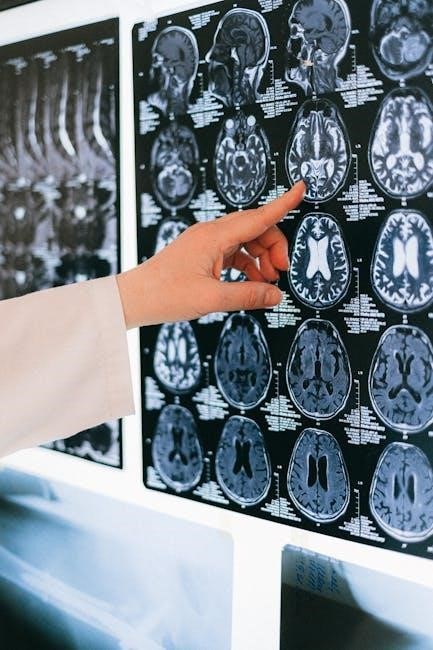The nervous system, comprising the brain, spinal cord, and nerves, is a complex communication network․ It controls bodily functions, enabling movement, sensation, and regulation of internal processes․
1․1 Definition and Overview
The nervous system is a intricate network of specialized cells and tissues that enables communication within the body․ It consists of the central nervous system (CNS), including the brain and spinal cord, and the peripheral nervous system (PNS), comprising nerves and ganglia․ This system is responsible for controlling voluntary and involuntary body functions, such as movement, sensation, and internal regulation․ The brain acts as the central processing unit, coordinating responses to stimuli and managing cognitive processes․ The nervous system is essential for maintaining homeostasis, facilitating learning, and enabling interaction with the environment․ Its proper functioning ensures overall health and well-being․
1․2 Importance of the Nervous System
The nervous system plays a vital role in controlling and coordinating body functions, enabling survival and adaptation․ It facilitates communication between cells, organs, and the environment, ensuring responses to stimuli․ The nervous system regulates voluntary actions, such as movement, and involuntary processes, like digestion and heart rate․ It also governs sensory perception, cognitive functions, and emotional responses․ Damage to the nervous system can lead to severe impairments, highlighting its critical importance․ Its proper functioning is essential for maintaining homeostasis, enabling learning and memory, and supporting overall health and well-being․ Without it, the body cannot function cohesively or respond to internal or external changes effectively․
1․3 Structure and Function
The nervous system is structured into the central nervous system (CNS), including the brain and spinal cord, and the peripheral nervous system (PNS), comprising nerves․ The CNS processes information and controls bodily functions, while the PNS transmits signals between the CNS and the rest of the body․ Neurons, specialized cells, communicate through electrical and chemical signals, enabling rapid transmission of information․ This intricate network allows the nervous system to regulate voluntary movements, sensory perceptions, and involuntary processes like heart rate and digestion․ Its structure ensures efficient communication, enabling the body to respond to stimuli and maintain homeostasis․ This complex interplay of components is essential for overall bodily function and survival․

Central Nervous System (CNS)
The CNS, consisting of the brain and spinal cord, processes information and controls bodily functions; It works with the PNS to enable the body to function effectively․
2․1 Brain: Structure and Function
The brain, the central control center of the nervous system, consists of the cerebrum, cerebellum, and brainstem․ The cerebrum manages voluntary actions, thought, and emotion, while the cerebellum coordinates movement․ The brainstem regulates vital functions like breathing and heart rate․ It processes sensory input, enabling perception and response to stimuli․ The brain’s complex structure allows it to control both conscious and subconscious activities, making it essential for survival and adaptability․ Its functions include memory, problem-solving, and emotional regulation, underscoring its critical role in maintaining overall health and well-being․
2․2 Spinal Cord: Role and Significance
The spinal cord, a vital part of the central nervous system, acts as a communication pathway between the brain and the body․ It transmits nerve impulses, enabling voluntary and involuntary actions․ The spinal cord is protected by the vertebral column and meninges, ensuring its functionality․ It plays a crucial role in reflex actions, such as withdrawing a hand from a hot surface, without involving the brain․ Additionally, it coordinates autonomic functions like heart rate and digestion․ Damage to the spinal cord can lead to severe impairments, highlighting its importance in maintaining bodily functions and overall health․
2․3 Meninges: Protective Layers of the CNS
The meninges are three layers of protective membranes surrounding the brain and spinal cord․ They provide structural support and safeguard against mechanical injuries, infections, and toxins․ The dura mater, arachnoid mater, and pia mater work together to maintain cerebrospinal fluid circulation, which cushions the CNS․ This protective system is essential for the proper functioning of the brain and spinal cord, preventing damage that could lead to severe neurological deficits․ Infections like meningitis can inflame these layers, highlighting their critical role in central nervous system health․

Peripheral Nervous System (PNS)
The PNS is a network of nerves connecting the CNS to the body, enabling communication between the brain and sensory receptors or muscles․ It controls both voluntary and involuntary actions, such as movement and digestion, ensuring proper bodily functions․
3․1 Somatic Nervous System: Voluntary Actions
The somatic nervous system controls voluntary actions, enabling conscious movement through connections between the CNS and skeletal muscles․ It facilitates activities like walking, talking, and writing, allowing deliberate responses to stimuli․ This system relies on sensory feedback to refine motor functions, ensuring precise and coordinated actions․ Damage to this system can impair motor skills and voluntary movement, highlighting its crucial role in daily activities․ The somatic nervous system is essential for interacting with the environment and maintaining physical functionality․
3․2 Autonomic Nervous System: Involuntary Actions
The autonomic nervous system regulates involuntary functions, such as heart rate, digestion, and breathing․ It operates unconsciously, ensuring the body’s internal processes run smoothly without deliberate control․ This system is divided into the sympathetic and parasympathetic divisions, which respectively prepare the body for “fight or flight” and promote relaxation․ By maintaining homeostasis, the autonomic nervous system is vital for overall health․ Dysfunction can lead to issues like abnormal heart rhythms or digestive problems, emphasizing its critical role in sustaining life and adapting to environmental changes without conscious intervention․
3․3 Nerves: Types and Functions
Nerves are bundles of nerve fibers that transmit signals between the central nervous system (CNS) and the rest of the body․ They are classified into three main types: sensory, motor, and mixed nerves․ Sensory nerves carry information from sensory receptors to the CNS, enabling perception of stimuli like touch, pain, or temperature․ Motor nerves transmit signals from the CNS to muscles and glands, facilitating voluntary and involuntary actions․ Mixed nerves contain both sensory and motor fibers, ensuring efficient communication․ Nerves play a vital role in controlling bodily functions, including movement, sensation, and internal organ regulation․ Damage to nerves can lead to disorders such as neuropathy, affecting nerve function and causing symptoms like numbness or pain․

Functions of the Nervous System
The nervous system controls bodily functions, facilitates movement, enables sensation, and regulates internal processes․ It allows interaction with the environment and maintains overall health and well-being․
4․1 Sensory Input: Receiving Information
The nervous system captures sensory information through specialized receptors, detecting stimuli like touch, temperature, and pain․ These signals are transmitted to the brain via nerves, enabling interpretation and response․ Sensory input is crucial for awareness, guiding voluntary actions, and maintaining internal balance․ The brain processes this data to recognize patterns and make decisions․ Without sensory input, the body would lack the ability to react to its environment, highlighting the nervous system’s vital role in maintaining overall function and interaction with the world․
4․2 Motor Functions: Responding to Stimuli
Motor functions enable the body to respond to stimuli through voluntary and involuntary actions․ The nervous system transmits signals from the brain to muscles and glands, initiating movement․ Voluntary actions, such as walking or writing, are controlled by the somatic nervous system․ Involuntary responses, like reflexes, are managed by the autonomic nervous system․ The brain coordinates these functions, ensuring precise and timely reactions; Efficient motor responses are essential for daily activities, maintaining balance, and reacting to danger․ This highlights the nervous system’s critical role in connecting thought and physical action, ensuring seamless interaction with the environment․
4․3 Regulatory Functions: Maintaining Homeostasis
The nervous system plays a vital role in maintaining homeostasis by regulating internal processes․ It monitors and adjusts bodily functions such as heart rate, blood pressure, and body temperature․ Through the autonomic nervous system, it balances sympathetic and parasympathetic responses, ensuring optimal organ function․ Hormonal regulation, particularly through the hypothalamus and pituitary gland, is also controlled by the nervous system․ This intricate balance allows the body to adapt to external and internal changes, preserving overall health․ The nervous system’s regulatory functions are essential for sustaining life and enabling the body to function efficiently under various conditions․

The Role of the Brain
The brain is the central organ of the nervous system, controlling thoughts, emotions, and bodily functions․ It enables communication and coordination within the body․
5․1 Cognitive Functions: Thinking and Memory
The brain’s cognitive functions include thinking, memory, and problem-solving․ These processes are essential for learning, decision-making, and adapting to new situations․ Memory involves storing and retrieving information, while thinking enables logical reasoning and creativity․ Research shows that practices like meditation and mindfulness can enhance these functions by improving attention and reducing cognitive decline․ Additionally, a healthy diet rich in antioxidants supports brain health, promoting better cognitive performance․ Understanding these aspects helps in developing strategies to maintain and improve mental acuity throughout life․
5․2 Emotional Regulation: Managing Feelings
Emotional regulation is a critical function of the nervous system, enabling individuals to manage and respond to feelings appropriately․ The brain processes emotions through structures like the amygdala and prefrontal cortex, balancing instinctual reactions with rational decisions․ Stress can disrupt this balance, leading to emotional instability․ Techniques such as mindfulness and meditation have been shown to enhance emotional regulation by strengthening neural pathways that promote calm and focus․ A healthy lifestyle, including exercise and social support, further supports emotional well-being․ Understanding how the nervous system manages emotions can help individuals develop strategies to maintain mental stability and resilience in challenging situations․
5․3 Control of Body Functions: Hormones and Reflexes
The nervous system orchestrates body functions through hormones and reflexes, ensuring seamless physiological operations․ Hormones, regulated by the endocrine system, are chemical messengers influencing growth, metabolism, and reproductive processes․ The hypothalamus and pituitary gland play pivotal roles in hormone production and distribution․ Reflexes, automatic responses to stimuli, are controlled by neural pathways, enabling rapid reactions like withdrawing a hand from heat․ This interplay between hormonal and reflex systems maintains homeostasis, adapting the body to internal and external changes․ Dysregulation in these processes can lead to disorders, highlighting the nervous system’s critical role in overall health and bodily function coordination․


Importance of the Nervous System in Daily Life
The nervous system is vital for daily functioning, enabling coordination, balance, learning, memory, and emotional well-being․ It facilitates interactions with the environment and maintains overall health․
6․1 Coordination and Balance
Coordination and balance are essential functions managed by the nervous system․ The brain processes sensory input from muscles and joints to maintain posture and movement․ This integration ensures smooth physical activities, preventing falls and injuries․ Balance is regulated through the vestibular system in the inner ear, which communicates with the brain․ Disruptions in this system can lead to issues like vertigo or dizziness, highlighting its importance in daily life․ Proper coordination enables tasks like walking, sports, and fine motor activities, making it crucial for overall mobility and independence․
6․2 Learning and Memory
Learning and memory are fundamental functions of the nervous system, primarily managed by the brain․ The brain processes information, creates connections between neurons, and stores memories․ This complex process involves electrical and chemical signals, enabling us to acquire new skills and knowledge․ Memory formation is linked to emotions and experiences, making it a dynamic and highly individualized process․ The nervous system’s efficiency in organizing and retrieving information is crucial for education, problem-solving, and daily tasks․ Factors like stress and lifestyle can influence memory, underscoring the importance of maintaining a healthy nervous system to support cognitive functions and overall intellectual growth․
6․3 Emotional Well-being
Emotional well-being is deeply intertwined with the nervous system, which regulates feelings and responses to stress․ The brain processes emotions, influencing mood and mental health․ A balanced nervous system fosters resilience, enabling individuals to manage stress and maintain emotional stability․ Practices like meditation and mindfulness can enhance nervous system function, promoting emotional well-being․ Conversely, chronic stress can disrupt this balance, leading to anxiety or depression․ Maintaining a healthy lifestyle, including exercise and proper nutrition, supports the nervous system and overall emotional health․ Understanding this connection underscores the importance of caring for the nervous system to achieve mental and emotional equilibrium in daily life․

Lifestyle Factors Affecting the Nervous System
Lifestyle choices significantly impact nervous system health․ Diet, exercise, stress levels, and sleep quality influence its function, affecting overall well-being and cognitive performance․
7․1 Diet and Nutrition
A balanced diet rich in essential nutrients is crucial for nervous system health․ Foods high in antioxidants, vitamins, and minerals support brain function and protect against neurodegeneration․ Omega-3 fatty acids found in fish and nuts promote neural health, while whole grains and fruits provide sustained energy․ Adequate hydration is also vital for maintaining nerve function․ A poor diet lacking these elements can lead to cognitive decline and increased risk of neurological disorders․ Incorporating nutrient-dense foods into daily meals helps maintain optimal nervous system performance and overall well-being․
7․2 Exercise and Physical Activity
Regular exercise plays a vital role in maintaining nervous system health․ Physical activity promotes blood flow to the brain, enhancing oxygen delivery and nutrient absorption․ This supports neural function and overall cognitive performance․ Exercise also stimulates the release of endorphins, which improve mood and reduce stress․ Activities like yoga and mindfulness practices further benefit the nervous system by fostering emotional regulation and reducing anxiety․ Consistent physical activity strengthens neural connections, potentially slowing neurodegeneration and improving memory․ Incorporating exercise into daily routines is essential for sustaining nervous system function and mental well-being․
7․3 Stress Management
Effective stress management is crucial for maintaining nervous system health․ Chronic stress can disrupt neural function, impairing cognitive abilities and emotional regulation․ Techniques like meditation, mindfulness, and deep breathing help mitigate stress by calming the nervous system․ These practices reduce cortisol levels, promoting a balanced emotional state․ Yoga and relaxation exercises also support nervous system well-being by enhancing parasympathetic activity, which fosters calmness․ Additionally, engaging in hobbies and spending time with loved ones can alleviate stress․ Prioritizing stress management through these methods is essential for preserving nervous system function and overall mental health, ensuring long-term well-being and resilience against stress-related challenges․

Creating Effective Nervous System PDFs
Designing clear, concise PDFs on the nervous system involves organizing content logically․ Use visuals and headings to enhance readability․ Ensure SEO optimization for better visibility online․
8․1 Design Considerations for PDFs
When creating PDFs about the nervous system, prioritize clarity and readability․ Use clear fonts, proper headings, and bullet points for organized content․ Incorporate visuals like diagrams or infographics to illustrate complex concepts․ Ensure proper spacing and a logical layout to enhance user experience․ Optimize for SEO by including relevant keywords in titles and metadata․ Use hyperlinks for references or additional resources․ Ensure compatibility across devices for consistent viewing․ Include a table of contents for easy navigation․ Use high-quality images and charts to support textual information․ Finally, proofread for accuracy and ensure the content is engaging and informative for the target audience․
8․2 Content Creation: What to Include
When creating a PDF on the nervous system, include detailed chapters and subsections for comprehensive coverage․ Start with an overview of the nervous system, followed by sections on CNS and PNS․ Use bullet points to highlight key topics like neurons, synapses, and neurotransmitters․ Incorporate diagrams and infographics to visualize complex structures․ Add definitions for medical terms and a glossary for easy reference․ Include practical tips on maintaining nervous system health, such as diet, exercise, and stress management․ Provide case studies or examples of disorders for better understanding․ Ensure the content is well-organized, with clear headings and subheadings․ Use engaging language to keep readers interested and informed․ Always cite credible sources and include a bibliography for further reading․ Make sure the PDF is navigable with a table of contents and index for quick access to specific topics․ Avoid overly technical jargon to ensure accessibility for all readers․ Finally, proofread for accuracy and clarity to ensure the PDF is both informative and professional․
8․3 SEO for PDFs: Maximizing Visibility
To maximize the visibility of your nervous system PDF, incorporate SEO strategies․ Use relevant keywords like “nervous system PDF” in the title and metadata․ Ensure the content is optimized with headings and subheadings․ Include a table of contents with internal links for better navigation․ Optimize images with alt text and descriptive file names․ Use text layers instead of scanned images for searchability․ Submit your PDF to Google Scholar or other academic platforms for higher visibility․ Share the PDF on social media, blogs, and forums to drive traffic․ Regularly update the content to keep it relevant and improve search rankings․ By following these tips, your PDF can reach a wider audience and become a valuable resource for learners and researchers alike․

Disorders of the Nervous System
Nervous system disorders include neurodegenerative diseases, mental health conditions, and peripheral nerve issues․ These affect the CNS and PNS, leading to cognitive, emotional, and physical impairments․ Early diagnosis and treatment are crucial for managing symptoms and improving quality of life․ Understanding these disorders is essential for developing effective therapies and raising awareness․ Proper medical intervention can significantly impact recovery and long-term health outcomes for individuals affected by nervous system conditions․
9․1 Neurodegenerative Diseases
Neurodegenerative diseases are conditions that progressively damage the nervous system, leading to cognitive decline and motor dysfunction․ Alzheimer’s and Parkinson’s are prominent examples, affecting millions worldwide․ These diseases result from protein misfolding and neuronal death․ Symptoms include memory loss, tremors, and impaired movement․ While there is no cure, treatments aim to manage symptoms and slow progression․ Research focuses on understanding disease mechanisms to develop effective therapies․ Early diagnosis through biomarkers and imaging is crucial for improving patient outcomes․ These diseases highlight the importance of nervous system health and the need for ongoing medical advancements to combat their devastating effects․
9․2 Mental Health Disorders
Mental health disorders, such as anxiety and depression, profoundly impact the nervous system․ These conditions often stem from imbalances in neurotransmitters and stress responses․ Anxiety, for instance, triggers heightened alertness, while depression can slow neural communication․ The nervous system plays a critical role in emotional regulation, and dysfunction can lead to these disorders․ Lifestyle factors, such as stress and lack of mindfulness, exacerbate symptoms․ Treatments often include therapy, medication, and mindfulness practices to restore balance․ Understanding the nervous system’s role in mental health is essential for developing effective interventions and improving quality of life for those affected by these conditions;
9․3 Peripheral Nervous System Disorders
Peripheral nervous system (PNS) disorders affect the nerves outside the brain and spinal cord․ Conditions like Guillain-Barré syndrome and chronic inflammatory demyelinating polyneuropathy disrupt nerve function․ Symptoms include numbness, tingling, and muscle weakness․ These disorders can result from infections, autoimmune responses, or nerve damage․ For instance, diabetes often causes peripheral neuropathy, leading to pain and sensory loss․ Treatment options include physical therapy, medications, and addressing underlying causes․ Understanding these conditions is crucial for developing targeted therapies to restore nerve function and improve quality of life․ Proper diagnosis and care are essential to manage PNS disorders effectively and prevent long-term damage․
The nervous system is vital for controlling bodily functions, enabling movement, sensation, and regulating internal processes․ Understanding its structure and functions is essential for maintaining health and well-being․
10․1 Summary of Key Points
The nervous system is a complex network controlling bodily functions, enabling movement, sensation, and internal regulation․ It comprises the central nervous system (CNS) and peripheral nervous system (PNS), working harmoniously to maintain homeostasis․ The CNS, including the brain and spinal cord, processes information and directs responses, while the PNS connects the CNS to sensory receptors and effectors․ Lifestyle factors like diet, exercise, and stress management significantly impact nervous system health․ Disorders such as neurodegenerative diseases and mental health conditions highlight the importance of understanding and caring for this vital system․ Its proper functioning is essential for overall well-being and quality of life․
10․2 Future Directions in Nervous System Research
Future research in the nervous system focuses on advancing understanding of its intricate functions and improving treatments for disorders․ Emerging areas include the polyvagal theory, exploring the brain’s role in emotional regulation, and developing bioelectronic interfaces to restore nerve function․ Studies on neuroplasticity aim to enhance recovery from injuries and diseases․ Additionally, research into cognitive training, meditation, and mindfulness seeks to optimize mental health and performance․ Advances in neuroimaging and AI-driven analytics promise deeper insights into nervous system dynamics․ These innovations hold potential to revolutionize diagnostics, therapies, and overall nervous system care, paving the way for a healthier future․
10․3 Final Thoughts on the Importance of the Nervous System
The nervous system is the cornerstone of human existence, orchestrating every thought, emotion, and bodily function․ Its intricate network ensures survival and quality of life, from regulating appetite to enabling cognitive processes․ By understanding its complexities, we can better appreciate its role in health and disease․ Protecting and maintaining nervous system health through lifestyle choices, like balanced diets and stress management, is crucial․ As research advances, so does our ability to prevent and treat disorders, enhancing overall well-being․ The nervous system’s importance cannot be overstated—it is the essence of who we are and how we experience the world․
